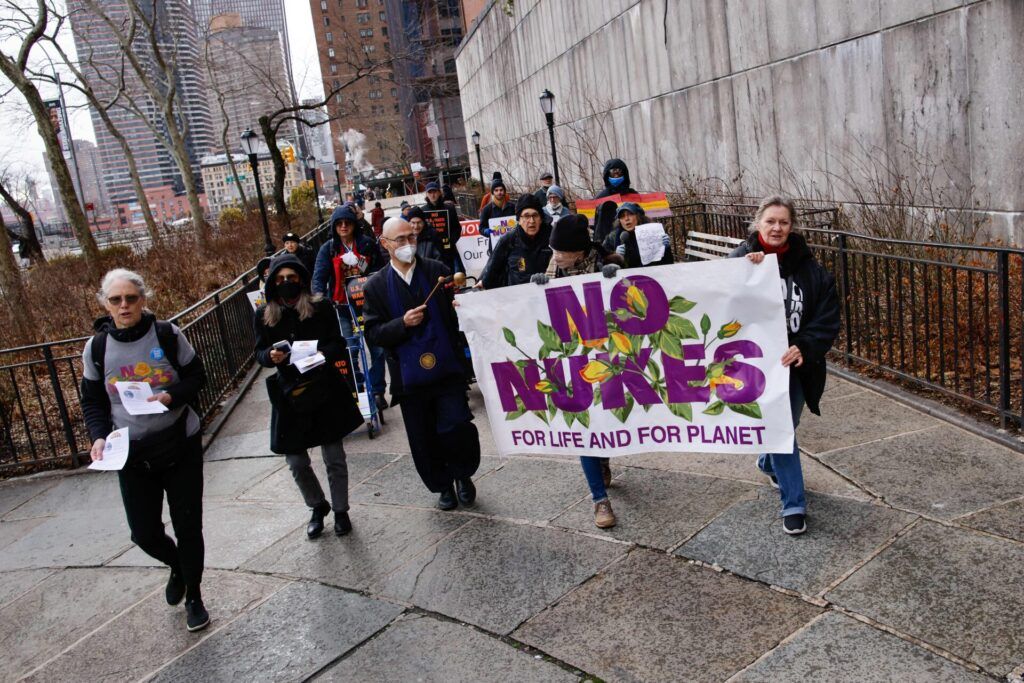Nuclear deterrence is the existential threat, not the nuclear ban treaty
By Ivana Nikolić Hughes, Xanthe Hall, Ira Helfand, Mays Smithwick | January 22, 2024
 Antinuclear activist march to mark the second anniversary of the entry into force of the Treaty on the Prohibition of Nuclear Weapons (TPNW) in New York, January 20, 2023. - The TPNW, the first legally binding international agreement to prohibit nuclear weapons, entered into force on January 22, 2021. (Photo by KENA BETANCUR/AFP via Getty Images)
Antinuclear activist march to mark the second anniversary of the entry into force of the Treaty on the Prohibition of Nuclear Weapons (TPNW) in New York, January 20, 2023. - The TPNW, the first legally binding international agreement to prohibit nuclear weapons, entered into force on January 22, 2021. (Photo by KENA BETANCUR/AFP via Getty Images)
In a deeply misguided article in this publication, Zachary Kallenborn contends that the Treaty on the Prohibition of Nuclear Weapons (TPNW) is a threat to humanity. To build this narrative, Kallenborn does not simply present nuclear deterrence as a stable and useful framework for avoiding conventional wars. Rather, he goes beyond the common deterrence arguments to assert that nuclear weapons restrain world wars, which allows nations to work together on addressing existential threats. Nothing could be further from the truth.
Nuclear deterrence is a myth. Nuclear deterrence involves a nation state maintaining a believable threat of retaliation to deter an adversary’s attack. This relies on demonstrations of the readiness and the capacity to use nuclear weapons—a highly dangerous form of bluff which, in turn, makes those targeted increase their hardware and rhetoric. We are currently witnessing this kind of escalation among several nuclear weapon possessor states, which could result in nuclear war.
Nuclear deterrence rests on decision makers always behaving rationally; even if different states and parties weigh values, threats, and possible consequences in the same way, individual leaders do not always behave rationally. During the closing weeks of his presidency, Richard Nixon’s behavior was so erratic that James Schlesinger, the Secretary of Defense, instructed the Joint Chiefs of Staff to ignore any order to use nuclear weapons unless it was countersigned by himself and Secretary of State Henry Kissinger. Schlesinger had no authority to do this, and it is not clear the instructions would have been carried out if Nixon had ordered the use of nuclear weapons. After his electoral defeat in 2020, Donald Trump’s behavior was so bizarre that it triggered similar concerns in General Milley, the chair of the Joint Chiefs of Staff. But troubling behavior is not solely the province of US leaders. Boris Yeltsin, for example, had an alcohol problem, and the recent nuclear rhetoric from Russian leaders has been worrisome at best.
All leaders are capable of making bad decisions, and the stress of a military crisis, during which decisions might have to be made with limited or faulty intelligence and in a very compressed time frame, increases the chance that a leader would abandon the rational position that nuclear weapons should never be used and make a mistake that would be fatal for humanity.
The overarching assumption of nuclear deterrence is that the existence of nuclear weapons can continue indefinitely without anything ever going wrong, leading to the theory’s most concerning aspect: lack of plan B. In the words of Melissa Parke, the executive director of the International Campaign to Abolish Nuclear Weapons (ICAN), “Nuclear deterrence may well work until the day it doesn’t.” What happens when nuclear deterrence fails? The problem is that it is impossible to create a plan for that day. The International Committee for the Red Cross (ICRC) has been warning since 1945 that there can be no adequate humanitarian response even to a single nuclear weapon explosion, let alone to the hundreds or thousands that could be used in today’s conflicts. Contrary to the unrealistic logic of deterrence, many medical organizations and other civil society groups, including those that we are a part of, have been arguing, often for decades, that prevention is the only viable option.
The argument that nuclear deterrence has kept the world safe is simply wrong. Numerous close calls and near misses strongly suggest otherwise. From scholarly analyses to a simple list of such known incidents in the United States alone, the message is clear—we have been lucky, rather than smart. As UN Secretary General António Guterres stated at the 10th Nuclear Non-Proliferation Treaty Review Conference in 2022, “Luck is not a strategy.”
Close calls and near misses haven’t led to nuclear war yet. But nuclear weapons have been the cause of human suffering for decades. In addition to the horrors of what happened in Hiroshima and Nagasaki, nuclear weapons have already harmed millions of people in the process of being developed and tested. Devastatingly, governments of nuclear weapon possessors have harmed their own people, such as the people of Kazakhstan and the United States, and those whose care they’ve been entrusted with, such as the Indigenous people of Australia, the Marshall Islands, Kiribati, and Maohi Nui (French Polynesia). These humanitarian consequences have provided the impetus for action that is embedded in Articles 6 and 7 of the TPNW and a recently adopted resolution on nuclear justice in the UN General Assembly. Just in 2022, the global expenditure on nuclear weapons was $83 billion, an amount that could have been better spent on social programs and other needs. We are all harmed when societal needs are ignored in favor of weapons of mass destruction.
What the world needs to address other existential threats. Kallenborn is right that the world faces other global threats. And although some of them—just like nuclear weapons—have the potential to wipe out humanity, including a large asteroid impact or an emerging infectious disease, what is thoroughly different about nuclear weapons is that we have created them, and we can therefore eliminate them.
The majority of states in the world have access to the knowledge and very many have access to the means to build nuclear weapons, but they don’t. These states refrain from doing so because they see no value in having nuclear weapons. On the contrary, they recognize the threat that possessing nuclear weapons poses. Moreover, a verifiable process for ensuring that existing nuclear weapons have been eliminated and that new ones are not developed would have to be put in place as part of any nuclear abolition plan, including through the TPNW, with a competent international authority put in charge of this key process. Significant work on verification is ongoing through the International Monitoring System of the Comprehensive Test Ban Treaty Organization (IMS of CTBTO), the International Atomic Energy Agency (IAEA), and the TPNW’s own Scientific Advisory Group (SAG), which was formed last year.
The elimination of all nuclear weapons and a concurrent international system of verification and monitoring would result in a far better scenario than where we find ourselves today. Even a hypothetical situation in which a nation cheats to make a few weapons following their total elimination would be far less dangerous than where we are today with a current global arsenal of approximately 12,500 warheads, which could destroy the world over and over again.
Climate change is—like nuclear war—an existential threat of great urgency, as its effects are devastating and could make entire regions of the planet uninhabitable. Added to this, climate change is already exacerbating conflicts due to the increase in food scarcity and natural disasters that displace populations and paralyze economies. These impacts will get worse with time. Combined with nuclear weapons, this regional and global instability arguably poses the greatest threat to humanity, as the Bulletin has repeatedly made clear with time adjustments to its Doomsday Clock. At the time of the writing of this article, the clock stands at just 90 seconds to midnight.
Nuclear winter refers to the fact that even limited regional nuclear war, such as between India and Pakistan, will trigger global climate disruption and catastrophic famine. Kallenborn alludes to this potential threat but tries to minimize the importance of nuclear winter studies by stating that there is a significant difference of opinion about this danger in the scientific community. He goes even further to warn us that such studies are motivated by “political biases and agendas.” Indeed, the one recent study from the Los Alamos Laboratory that minimizes the extent of climate change due to nuclear war may well be motivated by an agenda other than science; this study has been thoroughly rebutted. Incredibly, Kallenborn proposes that the response to the threat of global nuclear famine should be stockpiling enough food to feed billions of people for several years and cites the utterly inappropriate example of the 1948 Berlin airlift as the kind of effort needed.
Global cooperation, not threats of annihilation, must be the basis for addressing all existential threats. We live on a beautiful planet with a host of human-made and natural challenges that require us to move away from us vs. them attitudes and instead collectively cooperate to achieve global security for all humans in our common home. To this end, we must not normalize violent conflict on battlefields and threats to destroy one another. Instead, competition between states should be reserved for athletic fields and courts, business and commerce, and pursuit of scientific and artistic achievements.
The truth about the nuclear ban treaty. Arguably, the biggest falsehoods that Kallenborn promulgates revolve around the TPNW itself. For one, the treaty is not a quick fix that will lead to a sudden abolition of nuclear weapons in a vacuum. Rather, the treaty is an instrument that establishes a legal norm, which will lead to a process resulting in the elimination of nuclear weapons. The path that needs to be taken to reach this goal will, in itself, address the problem of great powers’ conflict and regional conflicts, as well as safe disarmament.
It is commonly claimed that nuclear deterrence has prevented a nuclear war from occurring. But we came to the brink of nuclear war several times during the Cold War, including during the Cuban Missile Crisis, and this claim about deterrence completely ignores the role of international agreements in de-escalating tensions and preventing a nuclear conflict. The process of creating instruments of arms control and disarmament establishes structures for regaining trust and verification. In this regard, the last decade has seen an erosion of the disarmament architecture, with the exception of the TPNW. As it stands, we may soon have no more brakes on the arms race.
As Kallenborn himself states, “the best way to reduce the risks of nuclear war is to ensure it never happens in the first place.” That precisely is the intention and the motivation of all of the 122 states that negotiated the TPNW in 2017 and an even larger number of states that have been voting in support of the treaty at the UN General Assembly every year since. The nine nuclear weapon possessors and their allies are the ones that need to prove that there is a convincing reason, or indeed any right, to hold the rest of the world hostage to their nuclear weapons. Kallenborn asserts that if nuclear weapons are eliminated, the great powers will launch World War III. In fact, the process of eliminating these weapons will create the conditions needed for a more cooperative relationship among the great powers, by removing the most dangerous issue that divides them.
The truth about the nuclear ban is spelled out in the text of the treaty itself, but also in the recently adopted Declaration that was the result of the Second Meeting of States Parties to the TPNW, held in New York late last year. The Declaration highlights the raison d’être for the ban, as well as the way forward.
Abolition is the only reasonable path. Nuclear weapons and current nuclear weapon policies are, in the words of the late peace and nuclear disarmament activist Daniel Ellsberg, “dizzyingly insane and immoral.” Aiming solely for reducing the harm or the possibility of harm that nuclear weapons could cause, rather than being a part of a process to abolish them, is simply not enough. Imagine if the opponents of slavery had aimed not to abolish slavery, but to make life a bit better for the enslaved people? Ultimately, the question of nuclear abolition is not just a moral one, but an existential one. If we don’t abolish nuclear weapons, they will abolish us. John F. Kennedy stated this at the United Nations more than 60 years ago. Let’s heed his words sooner rather than later and, critically, before it is too late.
Acknowledgements
The following individuals contributed significantly to the writing of this article:
Kati Juva, Physicians for Social Responsibility (PSR) Finland, IPPNW
Frank Boulton, Medact (IPPNW UK)
The following individuals endorse the views expressed in this article:
Michael Orgel, Medact Scotland & Medact UK Nuclear Weapons Group, Edinburgh
Timmon Wallis, NuclearBan.US
Hasse Schneidermann, Forbyd Atomvåben – ICAN in Denmark
Christian Ciobanu, NAPF and Reverse the Trend (RTT)
Alice Slater, World BEYOND War
Becker Raymond, Cercle Vivi Hommel, Luxembourg
Michele Di Paolantonio, AIMPGN Italian Medical Association for the Prevention of Nuclear War (IPPNW Italy)
Lisa Clark, Italian Peace and Disarmament Network
Kathleen Sullivan, Hiroshima Stories and NYCAN
Emily Welty, Pace University
Anastasia Shakhidzhanova, NAPF and Columbia University
Matthew Breay Bolton, Pace University
Spencer Graves, EffectiveDefense.org and PeaceWorks Kansas City
Gari Donn, UN House Scotland
Bill Kidd MSP, Scottish Parliament
Carol Gilbert, Grand Rapids Dominican Sister
Barbara Rose Johnston, Center for Political Ecology
Gerry Condon, Veterans For Peace, Golden Rule
John LaForge, Nukewatch
John Reuwer, PSR, World BEYOND War
Alan Robock, Rutgers University
Patrick Hiller, War Prevention Initiative
Donald A. Smith, PhD
David Hartsough, World Beyond War
Melissa Parke, ICAN
Steve Leeper, Peace Culture Village, Hiroshima
Carol Wolman, Voices for a Nuclear Free Future
David Swanson, World BEYOND War
Nicolas J. S. Davies, CODEPINK
Bobby Vaughn Jr, Investigative Journalist
Barbara Newsom, United Religions Initiative, Voices for a World Free of Nuclear Weapons
Jill Haberman, Peace & Justice Coordinator for Sisters of St. Francis of Assis, WI
Rosemary Field, Medact, UK
Jay Coghlan, Nuclear Watch New Mexico
Glenn Carroll, Nuclear Watch South
Ruth Mitchell, IPPNW
Susan Mirsky, MA Peace Action
Paul Andrews, Voices for a World Free of Nuclear Weapons
Tom Sauer, Universiteit Antwerpen, Belgium
Oda Andersen Nyborg, The Norwegian Peace Council
Diane Fine, MA 350
Lisa Fredrikson, Veterans For Peace
Veterans for Peace
Cynthia Lazaroff, Women Transforming Our Nuclear Legacy and NuclearWakeUpCall.Earth
Frank Bognar, NAPF
Kim Joy Bergier, Michigan Stop the Nuclear Bombs Campaign
Andrew S. Kanter, PSR and Columbia University
Linda Pentz Gunter, Beyond Nuclear
John Raby, Peace Action Maine
Michael Ramos, Voices for a World Free of Nuclear Weapons
Lynne Hall, Massachusetts Peace Action
Joni Arends, Concerned Citizens for Nuclear Safety, New Mexico
Ludo De Brabander, Vrede vzw (Belgian peace movement)
Carol E Green, Peace with Justice Committee, the Holston Conference of the United Methodist Church
Haruko Moritaki, Hiroshima Allians for Nuclear Weapons Abollition
WE Rotary Club of International Peace, TRUST Climate Action Strategists
Lynn Jamieson, Scottish Campaign for Nuclear Disarmament
Martin Fleck, PSR
Philip Webber, Scientists for Global Responsibility (UK)
Tom Vilmer Paamand, Aldrig Mere Krig – WRI Denmark
Hsin Yen Phoebe Mok, beHuman
Janet Fenton, Secure Scotland
Cletus Stein, Alliance for Nuclear Accountability
- Sunny Robinson, public health nurse, retired.
Jack Cohen-Joppa, the Nuclear Resister
Felice Cohen-Joppa, the Nuclear Resister
Cherrill Spencer, DISARM/End Wars Committee of the Women’s International League for Peace and Freedom, US Section
Gar Smith, Environmentalists Against War
Kathleen Hamill, Mass Peace Action and NuclearBan.US
Helen Caldicott, PSR
Tomohiko Aishima, Soka Gakkai International (SGI)
Anna Ikeda, SGI and Voices for a World Free of Nuclear Weapons
John Hallam, People for Nuclear Disarmament
Tove Jensen, Demos, The Initiative for Peace
Angel Ballesteros, Justice and Peace Spain and University of Burgos
Claus Montonen, Technology for Life Finland, International Network of Engineers and Scientists for Global Responsibility
Hunter Peace Group NSW Australia
Martha Inés Romero, Pax Christi International
Fco. Javier Alonso, Comisión General Justicia y Paz de España
Maribel Hernández, Alianza por el Desarme Nuclear
Juliane Hauschulz, ICAN Germany and IPPNW Germany
Anthony Donovan, Veterans For Peace, Catholic Worker, War Resister League, Peace Action NY, Pax Christi NY, ICANW
Per Kristensen
Marian Losse, ICAN Deutschland
Mary T. Yelenick, Pax Christi International
Ranjith Jayasekera, Sri-Lanka Doctors for Peace and Development
Kenneth Chiu, NAPF
Elizabeth Waterston, Medact (IPPNW UK)
Ghassan Shahrour
Richard Krushnic, Massachusetts Peace Action, Mass Public Banking, Cambridge Residents Alliance, Boston Workers Circle
Seth Shelden, ICAN
Robert Kinsey, The Colorado Coalition for Prevention of Nuclear War
Linda Cataldo Modica, Catholic Committee of Appalachia TN Chapter
Linda Chapman, NYCAN & Youth Arts New York
Together, we make the world safer.
The Bulletin elevates expert voices above the noise. But as an independent nonprofit organization, our operations depend on the support of readers like you. Help us continue to deliver quality journalism that holds leaders accountable. Your support of our work at any level is important. In return, we promise our coverage will be understandable, influential, vigilant, solution-oriented, and fair-minded. Together we can make a difference.
Keywords: ICAN, Kallenborn, TPNW, Treaty on the Prohibition of Nuclear Weapons
Topics: Nuclear Risk, Nuclear Weapons


















The fact that the 45 years before nuclear weapons over a 100 million died due to war and the 80 years since they were invented only 10 million have died in war says more than anything else on how deterrence has worked. Sometimes the obvious is just that, obvious.
What about the United Nations ?
What about Euroepan union / European Economic Community / The European Coal and Steel Community, were created to avoid war between FR/ Germany ?
What about the lessons of war ?
What about economic interdependance ?
What about culture ?
Toutes ces actions fortes et positives n’ont eu aucun role pour éviter des guerres ?
Correlation does not imply causation for one, but for another, nuclear deterrence, even if it can be argued to be (and to have been) a viable strategy in the short term (dubious as such arguments are), it cannot provide the kind of long-term assurance of reducing this particular existential threat, because so long as the weapons exist with the risk of being used, the chance remains that they will end up being used, through one scenario or another! It is only logical, and the many near misses in the last almost 80 years proves this point quite well. The… Read more »